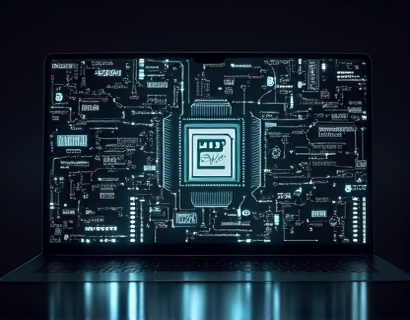Revolutionizing Digital Engagement: The Synergy of AI and Cryptocurrency
The intersection of artificial intelligence (AI) and cryptocurrency is redefining the landscape of digital engagement. This convergence is not just a technological curiosity but a transformative force that is reshaping how users interact with digital platforms and services. As we delve into this topic, it's essential to understand the fundamental roles that AI and cryptocurrency play individually and how their integration is leading to advanced solutions that enhance user experiences and drive growth in the tech ecosystem.
Understanding AI in the Digital Space
Artificial intelligence, a subset of computer science, focuses on creating systems that can perform tasks requiring human intelligence, such as learning, reasoning, and self-correction. In the digital realm, AI is employed to analyze vast amounts of data, recognize patterns, and make predictions or decisions with minimal human intervention. This capability is particularly valuable in enhancing user interactions by personalizing content, optimizing user interfaces, and providing intelligent recommendations.
One of the key applications of AI in digital engagement is natural language processing (NLP). NLP enables machines to understand, interpret, and respond to human language, making interactions more natural and intuitive. Chatbots, virtual assistants, and automated customer support systems are prime examples where NLP is used to provide immediate and relevant assistance to users, thereby improving satisfaction and loyalty.
Cryptocurrency: A New Paradigm for Digital Transactions
Cryptocurrency, on the other hand, represents a decentralized digital currency that uses cryptography for security and operates on a distributed ledger technology known as blockchain. The most well-known cryptocurrency, Bitcoin, was launched in 2009, but the concept has since expanded to include thousands of altcoins, each with unique features and use cases. Cryptocurrencies offer a secure, transparent, and tamper-proof way to conduct transactions, eliminating the need for intermediaries like banks.
The adoption of cryptocurrency is not limited to financial transactions. It has found applications in various sectors, including supply chain management, identity verification, and digital rights management. The inherent transparency and security of blockchain technology make it an ideal platform for building trust and ensuring integrity in digital interactions.
AI and Cryptocurrency: A Powerful Convergence
The combination of AI and cryptocurrency is creating a new frontier in digital engagement. By leveraging AI's analytical and predictive capabilities, cryptocurrency platforms can offer more sophisticated and user-friendly services. For instance, AI-driven trading bots can analyze market data, identify trends, and execute trades with high precision, providing users with potential investment opportunities that would be difficult to spot manually.
Moreover, AI can enhance the security of cryptocurrency transactions. Machine learning algorithms can detect and prevent fraudulent activities by identifying unusual patterns or behaviors. This not only protects users but also builds confidence in the cryptocurrency ecosystem, encouraging broader adoption.
Enhancing User Interactions Through AI-Powered Crypto Solutions
One of the most significant impacts of AI on cryptocurrency is the development of decentralized finance (DeFi) platforms. These platforms use smart contracts and AI to offer a range of financial services, including lending, borrowing, and yield farming, all without traditional financial intermediaries. AI algorithms can optimize these services by predicting market movements, managing risks, and personalizing user experiences.
For example, AI can be used to create personalized investment portfolios based on a user's risk tolerance, investment goals, and market conditions. This level of personalization is crucial in a space where the volatility of cryptocurrencies can be both a risk and an opportunity. By providing tailored advice and automated execution, AI helps users make informed decisions and maximize their returns.
Improving Accessibility and User Experience
The integration of AI in cryptocurrency also focuses on improving accessibility. For users who are new to the crypto space, the complexity of the technology can be daunting. AI-driven educational tools and interfaces can simplify these concepts, making it easier for beginners to understand and engage with cryptocurrency. Interactive tutorials, real-time feedback, and intuitive dashboards are just a few ways AI is making the crypto experience more approachable.
Additionally, AI can enhance the user interface of cryptocurrency applications. By analyzing user behavior and preferences, AI can adapt the interface to individual needs, ensuring a seamless and efficient user experience. This adaptability is particularly important in a market where user retention is key to success.
Driving Growth Through Data Analytics
Data analytics is another area where AI and cryptocurrency intersect to drive growth. Cryptocurrency exchanges and wallet providers generate vast amounts of data, including transaction histories, user behavior, and market trends. AI algorithms can process and analyze this data to uncover insights that can inform business strategies, improve user engagement, and identify new market opportunities.
For instance, by analyzing transaction patterns, AI can help identify peak usage times and optimize server resources to ensure smooth operations. Similarly, understanding user behavior can lead to the development of features that address specific pain points, thereby enhancing user satisfaction and loyalty. Data-driven insights also play a crucial role in marketing and customer acquisition, allowing for more targeted and effective campaigns.
Building Trust and Transparency
Trust is a fundamental component of any financial system, and cryptocurrency is no exception. AI can contribute to building trust by enhancing transparency and accountability. Blockchain's inherent transparency, combined with AI's ability to analyze and verify data, can create a more trustworthy ecosystem. For example, AI can be used to monitor and report on the performance of smart contracts, ensuring that all parties adhere to the agreed terms.
Furthermore, AI-powered auditing tools can detect anomalies and potential security breaches, providing an additional layer of protection for users. This level of transparency and security is essential for fostering a robust and sustainable cryptocurrency market.
Challenges and Considerations
While the potential benefits of AI in the cryptocurrency space are significant, there are also challenges and considerations that must be addressed. One of the primary concerns is the regulatory environment. As both AI and cryptocurrency are relatively new and rapidly evolving fields, regulatory frameworks are still catching up. Ensuring compliance with existing laws and anticipating future regulations is crucial for the sustainable growth of AI-powered crypto solutions.
Another challenge is the technical complexity involved in integrating AI with blockchain technology. Developing robust and scalable solutions requires expertise in both domains, which can be a barrier for some players in the market. Collaboration between AI experts and blockchain developers is essential to overcome these technical hurdles.
Future Prospects and Innovations
Looking ahead, the synergy between AI and cryptocurrency is poised to bring about even more innovative solutions. One area of interest is the development of AI-driven predictive models for cryptocurrency markets. These models can leverage machine learning to analyze historical data, economic indicators, and real-time market data to forecast price movements with greater accuracy. Such predictions can be invaluable for traders and investors looking to make informed decisions.
Another exciting development is the integration of AI with non-fungible tokens (NFTs) and decentralized applications (dApps). AI can enhance the functionality and user experience of NFTs, making them more than just digital collectibles. For instance, AI can be used to create dynamic and interactive NFT art, where the artwork evolves based on user interactions or external data sources.
Additionally, AI can play a pivotal role in the development of decentralized autonomous organizations (DAOs). By using AI to manage and optimize the operations of DAOs, these organizations can become more efficient and responsive to the needs of their members, further democratizing decision-making processes.
Conclusion
The convergence of AI and cryptocurrency is revolutionizing digital engagement by offering advanced solutions that enhance user interactions and drive growth in the tech ecosystem. From personalized investment advice to enhanced security and improved user experiences, the potential benefits are vast. As the technology continues to evolve, it is essential for tech professionals and enthusiasts to stay informed and adapt to the changing landscape. By embracing this synergy, we can unlock new possibilities and lead the way in digital transformation.











































